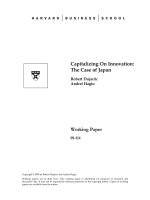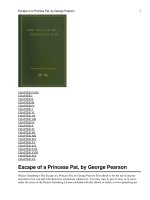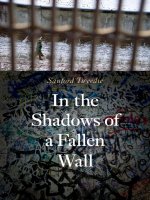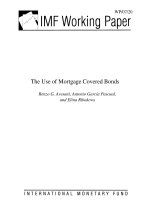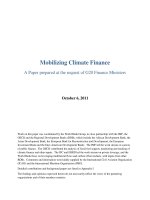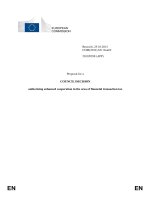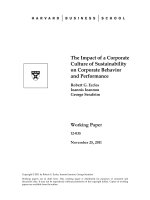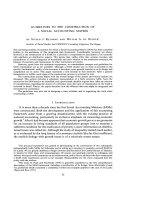On Estimating the Size of a Statistical Audit potx
Bạn đang xem bản rút gọn của tài liệu. Xem và tải ngay bản đầy đủ của tài liệu tại đây (177.32 KB, 20 trang )
On Estimating the Size of a Statistical Audit
Ronald L. Rivest
Computer Science and Artificial Intelligence Laboratory
Massachusetts Institute of Technology
Cambridge, MA 02139
November 14, 2006
∗
Abstract
We develop a remarkably simple and easily-calculated estimate for
the sample size necessary for determining whether a given set of n
objects contains b or more “bad” objects:
n(1 − exp(−3/b)) (1)
(This is for sampling without replacement, and a confidence level of
95%). The basis for this estimate is the following procedure: (a)
estimate the sample size t needed if sampling were to be done with
replacement, (b) estimate the expected number u of distinct elements
seen in such a sample, and finally (c) draw a sample of size u without
replacement. This formula is also remarkably accurate: exp eriments
show that for n < 5000, this formula gives results that are never too
small (with some exceptions when b = 1), but are never too large by
more than 4 (additively).
∗
The latest version of this paper can always be found at .
edu/
~
rivest/Rivest-OnEstimatingTheSizeOfAStatisticalAudit.pdf
1
1 Introduction
Given a universe of n objects, how large a sample should be tested to deter-
mine (with high confidence) whether a given number b of them (or more) are
bad?
We first present a simple approximate “rule of thumb” (the “Rule of
Three”) for estimating how big such a statistical sample should be, when
using sampling with replacement.
(This “Rule of Three” is simple and known, although perhaps not par-
ticularly well-known. Jovanovic and Levy [5] discuss the Rule of Three, its
derivation, and its application to clinical studies. See also van Belle [12].)
We then consider the question of how many distinct elements such a
sample really contains.
We finally provide an Improved Rule of Three for use with sampling with-
out replacement; it corrects for the bias in the Rule of Three due to sampling
with replacement rather than sampling without replacement, by only sam-
pling (now without replacement) the expected number of distinct elements
that the Rule of Three sample (with replacement) would have contained.
Saltman [10, Appendix B] was the first to study sample size (for sampling
without replacement) in the context of voting; the basic formulae he develops
for the optimal sample size are the ones we are trying to approximate here.
(There is much earlier relevant work on sampling theory, particularly the
notion of “lot acceptance sampling” in statistical quality control. For exam-
ple, the Dodge-Romig Sampling Inspection Tables [3], developed in the 1930’s
and first published in 1940, provide generalizations of the simple sampling
methods used here.)
Previous work by Neff [8] is noteworthy, particularly with regard to the
economies resulting from having a larger universe of many smaller, easily-
testable, objects. Brennan Center report [1, Appendix J] gives some simple
estimation formula, based on sampling with replacement. An excellent re-
port [4] on choosing appropriate audit sizes by Dopp and Stenger from the
National Election Data Archive Project is now also available; there is also
a nice associated audit size calculation utility on a web site [7]. Stanisle-
vic [11] also examines the issue of choosing a sufficient audit size; he gives a
particularly nice treatment of handling varying precinct sizes.
Some states, such as California, mandate a certain level (e.g. 1%) of
auditing [9].
This note is written for a fairly general audience.
2
2 Auditing Model
Suppose we have n “objects”. In a voting context, such an “object” might
typically be a precinct; it could also be a voting machine or an individual
ballot, depending on the situation; the math is the same.
We assume that we are in an adversarial situation, where an adversary
may have corrupted some of the objects. For example, the adversary might
have tampered with the results of some precincts in a s tate.
Thus, after the adversary has acted, each object is either “good” (that
is, clean, untampered with, uncorrupted), or “bad” (that is, tampered with,
corrupted).
We now wish to test a sample of the objects to determine with high
confidence whether the adversary has committed a “large” amount of fraud.
(With another standard formulation, we have an urn containing n balls,
b of which are black and n −b of which are white; we wish to sample enough
balls to have a sufficiently high probability of sampling at least one black
ball.)
We assume that each object is independently auditable. That is, we as-
sume the availability of a test or audit procedure that can determine whether
a given object is goo d or bad. We assume this test procedure is always cor-
rect. For example, testing the results of a given voting machine may involve
comparing the electronic results from the voting machine with a hand recount
of voter-verified paper ballots. If the comparison turns out to be equal, then
the machine is judged to be good; otherwise it is judged to be bad. Of course,
there may easily be explanations for the discrepancy other than malicious
behavior; such explanations might be determined with further investigation.
Nonetheless, for our purposes here, we’ll keep it simple and assume that each
object tested is found to be “good” or “bad.”
If we are trying to determine whether any fraud occurred, then we would
clearly need to test all objects in the worst case. Here we are willing to
sacrifice the ability to detect any fraud, and only detect with high confidence
whether or not a large amount of fraud has occurred, in return for having to
examine only a statistical sample of the objects; this is the usual notion of a
statistical test.
Let b denote the number of “bad” objects we wish to detect, where b
is a given constant, 1 ≤ b ≤ n. That is, we wish to determine, with high
confidence, if the number of corrupted objects is b or greater.
Since the adversary is trying to avoid detection, he will corrupt as few
3
object as possible, consistent with achieving his evil goals. We assume that
corrupting a number b of objects is sufficient to achieve his goals, and so we
may assume for our analysis that the adversary doesn’t try to corrupt more
than b objects.
We let
f = b/n (2)
denote the fraction of bad objects we wish to detect. In this note we call f the
“fraud rate.” Given one of b or f, the other is determined, via equation (2).
In a voting context, the value of b might be the requisite number of
precincts that the adversary would have to corrupt to swing the election.
If, for example, you assume (as is reasonable) that the adversary wouldn’t
dare to change more than 20% of the votes in any one precinct, and that the
“winner” won by a margin of v of the votes (where 0 ≤ v ≤ 1), then the
adversary would need to change a fraction
f = 2.5v (3)
of the precincts—or, equivalently,
b = 2.5vn (4)
precincts. (If all of the votes changed had been moved from the actual
winner to the alleged winner, then a margin of victory of a fraction v of
the votes cast by the alleged winner must have involved at least a fraction
v/(2 ∗ 0.20) = 2.5v of the precincts, since each precinct corrupted changes
the difference in vote count between the top two candidates by 40% of the
vote count of that precinct.) If the apparent winner has won by v = 1%
in a county with 400 precincts, you would want to test for b = 2.5vn = 10
or more bad precinct counts. See Saltman [10], Stanislevic [11], or Dopp et
al. [4] for further examples and excellent treatment of the issue of computing
appropriate target values b (or f) given a set of election results and possibly
varying precinct sizes.
We will be considering samples drawn both with replacement and without
replacement. For mnemonic convenience, we use t to denote sample sizes
when the sample is drawn with replacement, and u to denote sample sizes
when the sample is drawn without replacement. (Think of “u” for “unique”
or “distinct”.)
4
3 Sampling without replacement
We begin by reviewing the (well-known) math for determining the proper
sample size, when sampling without replacement. Although this math is not
complicated, the results seem to require the use of a computer program to
determine the optimal sample size.
The rest of this paper is then devoted to determined ways of accurately
estimating this optimal size, simple enough to be usable, if not by hand, at
least with the use of only a calculator, with no computer needed. (Your calcu-
lator must be a “scientific” one, though, so you can compute the exponential
function exp(x) = e
x
.)
Suppose we pick u objects to test, where 0 < u ≤ n. These u objects
are chosen independently at random, without replacement—the objects are
distinct.
(The question of how to pick objects “randomly” in a publicly verifiable
and trustworthy manner is itself a very interesting one; see Cordero et al. [2]
for an excellent discussion of this problem.)
In an election, if any of the u tested objects (e.g. precincts or voting
machines) turns out to be “bad,” then we may declare that “evidence of
possible fraud is detected” (i.e., at least one bad object was discovered).
Otherwise, we report that “no evidence of fraud was detected.” When a
bad object is detected, additional investigation and further testing may be
required to determine the actual cause of the problem.
We wish it to be the case that if a large amount of fraud has occurred
(i.e., if the number of corrupted objects is b or greater), then we have a high
chance of detecting at least one bad object.
Given that we are drawing, without replacement, a sample of size u from
a universe of size n containing b bad objects, the chance that at least one
bad object is detected is:
d(n, b, u) = 1 −
n − b
u
/
n
u
(5)
= 1 −
u−1
k=0
n − b − k
n − k
. (6)
For a given confidence level c (e.g. c = 0.95), the optimal sample size u
∗
=
u
∗
(n, b, c) is the least value of u making d(n, b, u) greater than c:
u
∗
(n, b, c) = min{u | d(n, b, u) > c } . (7)
5
Equations (5)–(7) are not new here; they have been given and studied by
others (e.g. [10, 8, 4]).
As a running example, consider the case when n = 400 and b = 10; we are
trying to determine if our set of 400 objects contains 10 or more bad ones.
Using a computer program to try successive values of u yields the result:
u
∗
(400, 10, 0.95) = 103 ; (8)
we need to test a sample (drawn without replacement) of size at least 103 in
order to determine if our set of 400 objects contains 10 or more bad objects,
with probability at least 95%.
In some sense, this completes the analysis of the problem; it is easy for
a computer program to determine the optimal sample size u
∗
(n, b, c), given
n, b, and c. (See where such a program may be
posted.)
However, it may nonetheless be valuable to find simple but accurate ap-
proximations for this optimal value u
∗
(n, b, c) of u, that can be easily c alcu-
lated without the use of a computer.
The rest of this note is devoted to this purpose.
We do so by first considering the same problem, but when sampling with
replacement. We then “correct” for the changes made by this assumption.
4 Sampling with replacement and the Rule
of Three
Here now is a simple “rule of thumb” that is easily remembered; it applies
when we are sampling with replacement. Since we are now sampling with
replacement, we use t to denote the sample size, and t
∗
(n, b, c) to denote
the optimal sample size (when sampling a set of size n with replacement, in
order to find at least one bad element, with probability at least c, when b bad
elements are present—this is analogous to the optimal sample size u
∗
(n, b, c)
for sampling without replacement).
6
Rule of Three:
Test enough objects so that, for the fraud level you are trying
to detect, you expect to see at least three corrupted objects
among those examined (via sampling with replacement). That
is, ensure that:
ft ≥ 3. (9)
or equivalently, ensure that:
t ≥ 3n/b . (10)
(Where t is the number of objects to be tested, b is the number
of bad objects one wishes to detect, and f = b/n, at a 95%
confidence level.)
As a simple example: to detect a 1% fraud rate (f = 0.01) (with 95%
confidence), you then need to test t = 300 objects.
Note that for a given fraud rate f, the rule’s sample size is independent of
the universe size n. (This may seem counter-intuitive at first, but is really to
be expected. If you have available some well-mixed sand where most of the
sand grains are white, but a fraction f of the grains are black, you may only
need to sample a handful of the sand to be confident of obtaining a black
grain, no matter whether the amount of sand to be examined is a cupful, a
bucketfull, or a beach.)
The sample size t may even be greater than n (if b < 3); this is OK since
we are sampling with replacement, and it may take more than n samples
(when sampling with replacement) to get adequate coverage when b is so
small.
We now justify the Rule of Three (for a confidence level of 95% that a
fraud rate of f or greater will be detected). (This analysis follows that given
by Jovanovic and Levy [5].)
The probability that a fraud rate of f or greater goes undetected (when
drawing a sample of size t with replacement) is at most:
(1 − f)
t
. (11)
If we want the chance that significant fraud goes undetected to be 5% or
less, then we want
(1 − f)
t
≤ 0.05
7
or equivalently:
t ≥
ln(0.05)
ln(1 − f)
(12)
Since
ln(0.05) = −ln(20) = −2.9957 ≈ −3
—isn’t it so very nice that ln(20) is almost exactly 3?—equation (12) becomes
t ≥
−3
ln(1 − f)
.
Using the well-known approximation
ln(1 − f) ≈ −f , (13)
which is quite accurate for small values of f, we can rewrite the bound on t
from equation (12) as:
t ≥
3
f
which can be rewritten as
t ≥
3n
b
(14)
or equivalently as
ft ≥ 3 . (15)
Equation (15) has a very nice and intuitive interpretation. Since t is the
number of objects tested, and f is the fraud rate, then ft is the number of
objects among the test objects that we would expect to find corrupted.
You want the test set to be big enough that you exp ect to see that at
least three corrupted test objects. If you sample enough so that you expect
to see at least three corrupted objects on the average, then you’ll see at least
one corrupted object almost always (i.e., at least 95% of the time).
(Similarly, a random variable X distributed according to the Poisson
distribution with mean λ > 3 satisfies Pr[X = 0] = e
−λ
< e
−3
= 0.04978 . . )
With our running example, we have n = 400, b = 10, and thus f = b/n =
0.025; the Rule of Three says to pick a sample of size 3n/b = 3∗400/10 = 120.
While this estimate is about 17% larger than the optimal value of 103 that
we computed earlier for sampling without replacement, it is nonetheless not
too bad for an estimate you can compute in your head.
8
This “Rule of Three” ( t > 3n/b ) is thus simple enough for some practical
guidance.
It is also easily adjusted. For example, for a 99% chance of detecting
fraud, we can similarly use the “Rule of Five”:
ft ≥ 5
≥ −ln(0.01) ≈ 4.6 .
We could call it the “Rule of 4.6”, but the name “Rule of Five” is easier
to remember. . . . For a confidence level of 99%, we should thus test enough
objects so that, for the fraud level we are trying to detect, we expect to see
at least five corrupted objects among those examined.
However, in practice one samples without replacement, instead of sam-
pling with replacement, so a sample s ize derived by assuming sampling with
replacement is going to be an overestimate—in some cases a serious overes-
timate. Nonetheless the Rule of Three, which can be applied in one’s head,
provides an easy “first rough guess” of the sample size that might be needed
in practice.
To summarize this sec tion, for general c, we have the following formula
for the optimal sample size t
∗
(n, b, c), when sampling with replacement:
t
∗
(n, b, c) =
ln(1 − c)
ln(1 − f)
(16)
=
ln(1 − c)
ln(1 − b/n)
(17)
or, using equation (13), we get the generalized form of the Rule of Three as
an approximation:
t
1
(n, b, c) =
−n ln(1 − c)
b
. (18)
(Here we ignore the fact that a sample size must be integral; in practice one
can just round the values up to the next integer if necessary.)
5 Adjusting for Sampling without Replace-
ment
In this section we propose a means for “correcting” the estimate given by the
Rule of Three, to account for the fact that in practice one samples without
9
replacement, instead of with replacement. The “correction” replaces the
estimate from the Rule of Three with an estimate of the number of distinct
objects seen when drawing (with replacement) a sample of the size suggested
by the Rule of Three. We call this modification the Improved Rule of Three.
There is no rigorous justification for the accuracy of this heuristic, but it
seems intuitively well-motivated, and experiments show it to be in fact very
accurate.
Suppose that we draw with replacement a sample of size t from a universe
of size n; how many distinct elements do we expect to see? Let s(n, t) denote
this number. (As a mnemonic, s(n, t) is the size of the set that is the support
for the multiset drawn of size t.)
The function s(n, t) is well studied. (The usual way of formulating the
question in the literature is: suppose one throws t balls into n bins uniformly
at random; how many bins remain empty? The expected value of this quan-
tity is n − s(n, t) in our notation.) Kolchin et al. [6, page 5,Theorem 1] give
the results (where r = t/n):
s(n, t) ≥ n(1 − exp(−r)) , and (19)
s(n, t) = n(1 − exp(−r)) +
r
2
exp(−r) − O(
r(1 + r) exp(−r)
n
) . (20)
We will ignore the last two terms of this equation, as they are small, and let
ˆs(n, t) = n(1 − exp(−t/n)) . (21)
Then ˆs(n, t) is our estimate of the expected number s(n, t) of distinct el-
ements in a sample of size t drawn (with replacement) from a set of size
n.
The approximation (21) is very accurate, but is always a slight underesti-
mate. The largest term in the power series for the error of this approximation
is t/2n. The estimation error is never more than 1/e = 0.367 . . .; this occurs
when n = t = 1. For a given n, the maximum error occurs when t = n; as
n gets large, this maximum error converges to 1/2e = 0.1839 . . Thus, the
approximate formula could be improved slightly by adding 0.1839 . . ., while
still remaining an underestimate, or instead by adding 0.3678 . . ., to yield an
upper bound:
ˆs(n, t) + 0.1839 . . . ≤ s(n, t) ≤ ˆs(n, t) + 0.3678 . . . . (22)
10
For example, when drawing (with replacement) a sample of size t = 120
from a universe of size n = 400 (following our running example), we don’t
expect to see 120 distinct objects; there will be some repetitions. The number
of distinct objects we expect to see is approximately
ˆs(400, 120) = 400(1 − exp(−120/400))
= 103.67 ;
approximately 120 − 104 = 16 of the 120 objects will have been “repeats.”
The qualitative behavior of s(n, t) for fixed t as n increases is quite simple.
When n is much smaller than t, s(n, t) is approximately n—we expect to see
almost all of the elements of the universe in the sample. When n = t, we
are at the knee of the curve, and s(n, t) ≈ 0.632n. As n increases beyond t,
s(n, t) approaches t asymptotically:
lim
n→∞
s(n, t) = t . (23)
Indeed, once n is larger than t
2
or so, we don’t expect to see repeats in our
sample, and so s(n, t) is then very nearly t.
Given then a universe of size n, and a target number b of bad objects
we wish to detect, instead of using the Rule of Three sample size (for a
confidence level of 95%):
t = 3n/b
we suggest “correcting” this by using instead the number of distinct elements
we expect to see in such a sample of size t, viz.:
u
1
(n, b, 0.95) = ˆs(n, t
1
(n, b, 0.95))
= n(1 − exp(−t
1
(n, b, 0.95)/n))
= n(1 − exp(−3/b)) .
For a general confidence level c, we have
u
1
(n, b, c) = ˆs(n, t
1
(n, b, c))
= n(1 − exp(ln(1 − c)/b)) .
This then gives us our Improved Rule of Three:
11
Improved Rule of Three:
Test enough objects so that:
u ≥ n(1 − exp(−3/b)) , (24)
where n is the size of the universe, u is the number of objects
to be tested, and b is the number of bad objects one wishes
to detect, at a 95% confidence level, using sampling without
replacement.
Although perhaps less “intuitive” than the original Rule of Three, the Im-
proved Rule of Three gives very accurate guidance, and it provides significant
savings when t/n gets large (say, more than 10%). There is no rigorous jus-
tification for the Improved Rule of Three, although we shall provide some
empirical justification for its accuracy.
When b < 3
√
n, the original Rule of Three in equation (14) gives that
t
1
(n, b, 0.95) >
√
n, so that repetitions may be common, and Improved Rule
of Three (u
1
) will indeed be an improvement over the original Rule of Three.
However, when b exceeds 3
√
n, then the Improved Rule of Three and the
original Rule of Three will give nearly identical results.
For our running example (n = 400,b = 10), equation (24) says to use
u
1
(400, 10, 0.95) = 400(1 − exp(−3/10))
= 103.67 .
This is within 0.67 of the correct answer (equation (8))!
For a confidence level of 99%, use a sample of size:
u
1
(n, b, 0.99) = n(1 − exp(−4.6/b)) . (25)
Empirically, for 1 ≤ n ≤ 5000 and all b, 1 ≤ b ≤ n, we always have
u
∗
(n, b, 0.95) − 1 ≤ u
1
(n, b, 0.95) ≤ u
∗
(n, b, 0.95) + 4 (26)
so that the Improved Rule of Three is seen to be exceptionally accurate
(always within 4 of the correct value for this range of n values). Moreover,
it appears almost never to underestimate the required sample size; there are
a few exceptional cases when b = 1 when the estimate u
1
is one less than u
∗
.
(These exceptional cases go away if we add 0.3678. . . to the estimate on the
right hand side of inequality (24) in line with the bound in (22).)
12
For c = 0.95 and n ≤ 5000, this approximation is one too small about
0.0007% of the time, correct about 0.09% of the time, one to o large about
29.96% of the time, two too large about 65.14% of the time, and three too
large about 4.79% of the time. The approximation is only occasionally too
small, and then only when b = 1; by increasing the approximation by adding
0.3678, in line w ith bound (22) the approximation never seems to be too
small, empirically.
A closely related estimate
u
2
(n, b, 0.95) = s(t
∗
(n, b, 0.95))
≈ min(n, n ∗ (1 − exp(−3/ ln(1 − b/n))) + 1)
yields very similar experimental results—the estimate always appears to be
conservative, but may be a little too large. (This estimate is based on plug-
ging equation (12) instead of equation (14) into equation (21), after adding
1 to ensure that the estimate is conservative, and taking the minimum with
n to ensure that the result is not too large.)
6 Discussion
We note (as other authors have as well) that overly simple rules, such as
“sample at a 1% rate”, are not statistically justified in general. Using the
Rule of Three, we see that a 1% sample rate is appropriate only when
t ≤ 0.01n
or
3n/b ≤ 0.01n
or
b ≥ 300 .
Since b is the total number of corrupted objects, we see that a 1% sampling
rate may be inadequate when n is small, or the fraud rate is small. . . (Of
course, the Rule of Three is only for sampling with replacement, but the
intuition it gives carries over to the case of sampling without replacement.)
The analysis of this paper doesn’t take into account the possibility that
different objects have different size or weight. For example, different voting
precincts may have different numbers of voters. This complicates matters
considerably. Stanislevic [11] has a good approach to handling this situation.
13
The empirical bounds given in equation (26) are not proven to hold in
general; it would be interesting to provide proofs (if indeed the bounds hold
in general).
We hope that the rules presented here will provide useful guidance for
those designing sampling procedures for audits.
Indeed, since the formula
n(1 − exp(−3/b)) (27)
is so simple, so accurate, and yet (almost) always appears to be conservative,
one could imagine just always using this sample size (instead of the optimal
value), or writing this formula into election law legislation mandating audit
sample size s. (To make it conservative, it appears to suffice to add 0.3678 to
this formula.) Along with this formula, one could perhaps mandate use of
equation (4) deriving the number of bad objects to test for from the apparent
margin of victory; the result says to sample
n(1 − exp(−1.2/vn)) (28)
objects, where v is the apparent margin of victory of the winner. (But
it would probably be best to merely mandate a sample size sufficient to
detect, with a specified level of confidence, any election fraud sufficient to
have changed the outcome. In addition, one may wish to ensure that objects
(e.g. precincts) with surprising or suspicious results also get examined.)
Acknowledgments
I’d like to thank Kathy Dopp, David Karger, Avi Rubin, Doug Jones, Harry
Khamis, and Howard Stanislevic for helpful comments and pointers.
References
[1] Brennan Center Task Force on Voting System Security (Lawrence Nor-
den, Chair). The machinery of democracy: Protecting elections in an
electronic world, 2006. Available at: />programs/downloads/Full%20Report.pdf.
14
[2] Arel Cordero, David Wagner, and David Dill. The role of dice in election
audits — extended abstract, June 16 2006. To appear at IAVoSS Work-
shop on Trustworthy Elections (WOTE 2006). Preliminary version avail-
able at: />~
daw/papers/dice-wote06.
pdf.
[3] Harold F. Dodge and Harry G. Romig. Sampling Inspection Tables:
Single and Double Sampling (2nd ed). Wiley, 1944.
[4] Kathy Dopp and Frank Stenger. The election integrity audit, 2006.
/>ElectionIntegrityAudit.pdf.
[5] B. D. Jovanovic and P. S. Levy. A look at the rule of three. American
Statistician, 51(2):137–139, 1997.
[6] Valentine F. Kolchin, Boris A. Sevast’yanov, and Vladimir P.
Chistyakov. Random Allocations. V. H. Winston & Sons (Washing-
ton, D. C.), 1978. (translated from Russian) Distributed by Halsted
Press, a Division of John Wiley & Sons, Inc.
[7] NEDA. Election integrity audit calculator. Available at: http:
//electionarchive.org/auditcalculator/eic.cgi.
[8] C. Andrew Neff. Election confidence— a comparison of methodolo-
gies and their relative effectiveness at achieving it (revision 6), De-
cember 17 2003. Available at: />ElectionConfidence.pdf.
[9] California Voter Foundation (press release). Governor signs land-
mark bill to require public audits of software vote counts, October
11 2005. Available at: />101105release.html.
[10] Roy G. Saltman. Effective use of computing technology in vote-tallying.
Technical Report NBSIR 75–687, National Bureau of Standards (In-
formation Technology Division), March 1975. Available at: http:
//csrc.nist.gov/publications/nistpubs/NBS_SP_500-30.pdf.
15
[11] Howard Stanislevic. Random auditing of e-voting systems: How much
is enough?, revision August 16, 2006. Available at: http://www.
votetrustusa.org/pdfs/VTTF/EVEPAuditing.pdf.
[12] Gerald van Belle. Statistical Rules of Thumb. Wiley, 2002.
16
Appendix A.
In this Appendix, we illustrate the use of our proposed estimate, and compare
it to the optimal sample size.
Each table is for a different number n of objects, from n = 2 to n =
10, 000.
Within a table, each row considers a different value of b, the number of
bad objects we wish to detect.
There are in each table two sections of two columns each, one for a con-
fidence level of c = 0.95 and one for a confidence level of c = 0.99. Within
each column we give the optimal number u
∗
(n, b, c) of elements in a sample
(drawn without replacement), and also our estimate
u
1
(n, b, c) = n(1 − exp(ln(1 − c)/b))
of the number of elements in a sample (again, drawn without replacement).
Values are shown rounded up to the next integer, as necessary.
Note the accuracy of the proposed estimate, over the entire range of values
n, b, and c. Note also that our estimate u
1
is almost always conservative (it
is almost never less than the optimal value u
∗
); in the charts it is only too
small for b = 1 and n = 5000, n = 10000. These exceptions disappear if we
add 0.3678 to the estimate.
c = 0.95 c = 0.99
n b opt est opt est
2 1 2 2 2 2
c = 0.95 c = 0.99
n b opt est opt est
5 1 5 5 5 5
5 2 4 4 4 5
c = 0.95 c = 0.99
n b opt est opt est
10 1 10 10 10 10
10 2 8 8 9 9
10 5 4 5 5 7
17
c = 0.95 c = 0.99
n b opt est opt est
20 1 19 19 20 20
20 2 16 16 18 18
20 5 9 10 11 13
20 10 4 6 6 8
c = 0.95 c = 0.99
n b opt est opt est
50 1 48 48 50 50
50 2 39 39 45 45
50 5 22 23 29 31
50 10 12 13 17 19
50 20 6 7 9 11
c = 0.95 c = 0.99
n b opt est opt est
100 1 95 95 99 99
100 2 78 78 90 90
100 5 45 46 59 61
100 10 25 26 36 37
100 20 13 14 19 21
100 50 5 6 7 9
c = 0.95 c = 0.99
n b opt est opt est
200 1 190 190 198 198
200 2 155 156 180 180
200 5 90 91 120 121
200 10 51 52 73 74
200 20 27 28 40 42
200 50 11 12 16 18
200 100 5 6 7 10
18
c = 0.95 c = 0.99
n b opt est opt est
500 1 475 475 495 495
500 2 388 389 450 450
500 5 225 226 300 301
500 10 129 130 183 185
500 20 69 70 101 103
500 50 28 30 42 44
500 100 14 15 21 23
500 200 6 8 9 12
c = 0.95 c = 0.99
n b opt est opt est
1000 1 950 950 990 990
1000 2 777 777 900 900
1000 5 450 451 601 602
1000 10 258 259 368 370
1000 20 138 140 204 206
1000 50 57 59 86 88
1000 100 29 30 43 46
1000 200 14 15 21 23
1000 500 5 6 7 10
c = 0.95 c = 0.99
n b opt est opt est
2000 1 1900 1900 1980 1980
2000 2 1553 1553 1800 1800
2000 5 901 902 1203 1204
2000 10 517 518 737 739
2000 20 277 279 410 412
2000 50 115 117 174 176
2000 100 58 60 88 91
2000 200 29 30 44 46
2000 500 11 12 16 19
2000 1000 5 6 7 10
19
c = 0.95 c = 0.99
n b opt est opt est
5000 1 4751 4750 4951 4950
5000 2 3882 3882 4500 4500
5000 5 2253 2254 3009 3010
5000 10 1294 1295 1844 1846
5000 20 695 696 1027 1029
5000 50 290 291 438 440
5000 100 147 148 223 226
5000 200 73 75 112 114
5000 500 29 30 44 46
5000 1000 14 15 21 23
5000 2000 6 8 10 12
c = 0.95 c = 0.99
n b opt est opt est
10000 1 9501 9500 9901 9900
10000 2 7764 7764 9000 9000
10000 5 4507 4508 6018 6019
10000 10 2588 2589 3689 3691
10000 20 1390 1392 2055 2057
10000 50 581 582 878 880
10000 100 294 296 448 451
10000 200 148 149 226 228
10000 500 59 60 90 92
10000 1000 29 30 44 46
10000 2000 14 15 21 23
10000 5000 5 6 7 10
20

